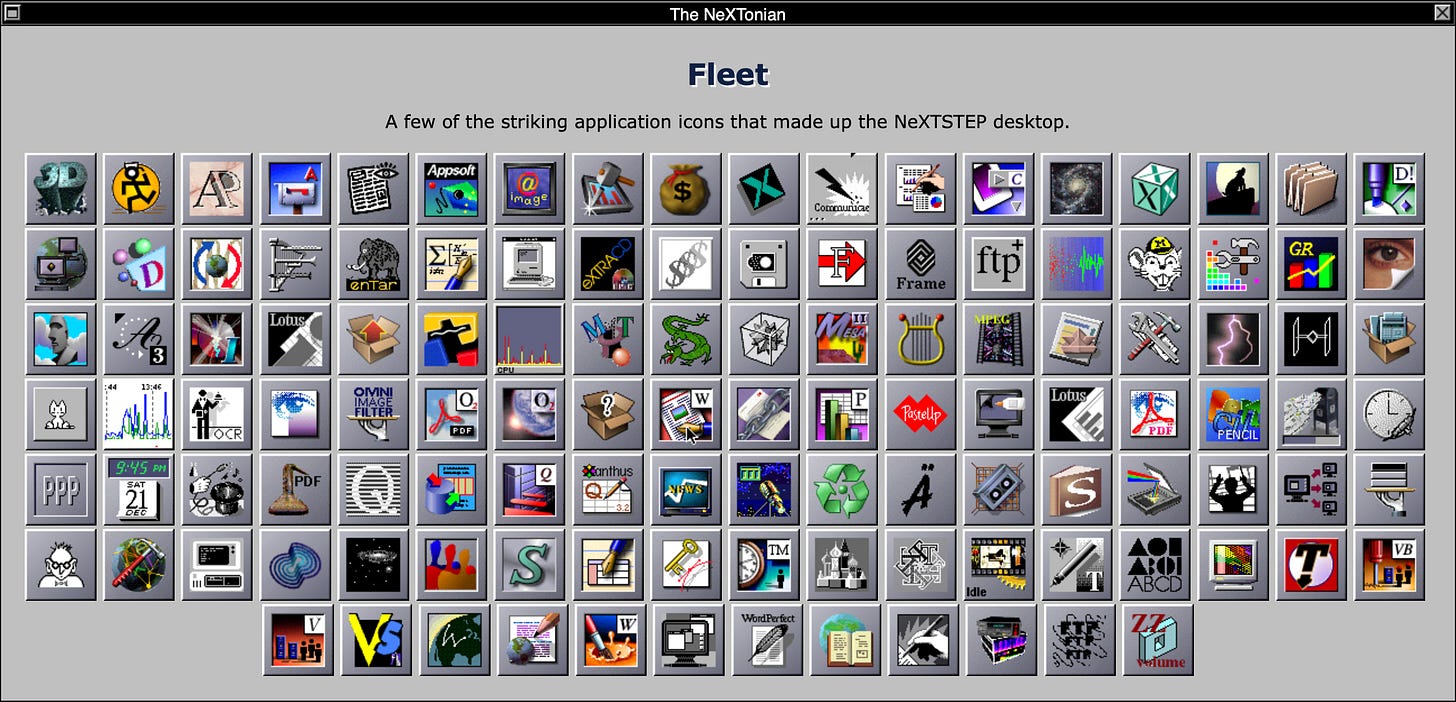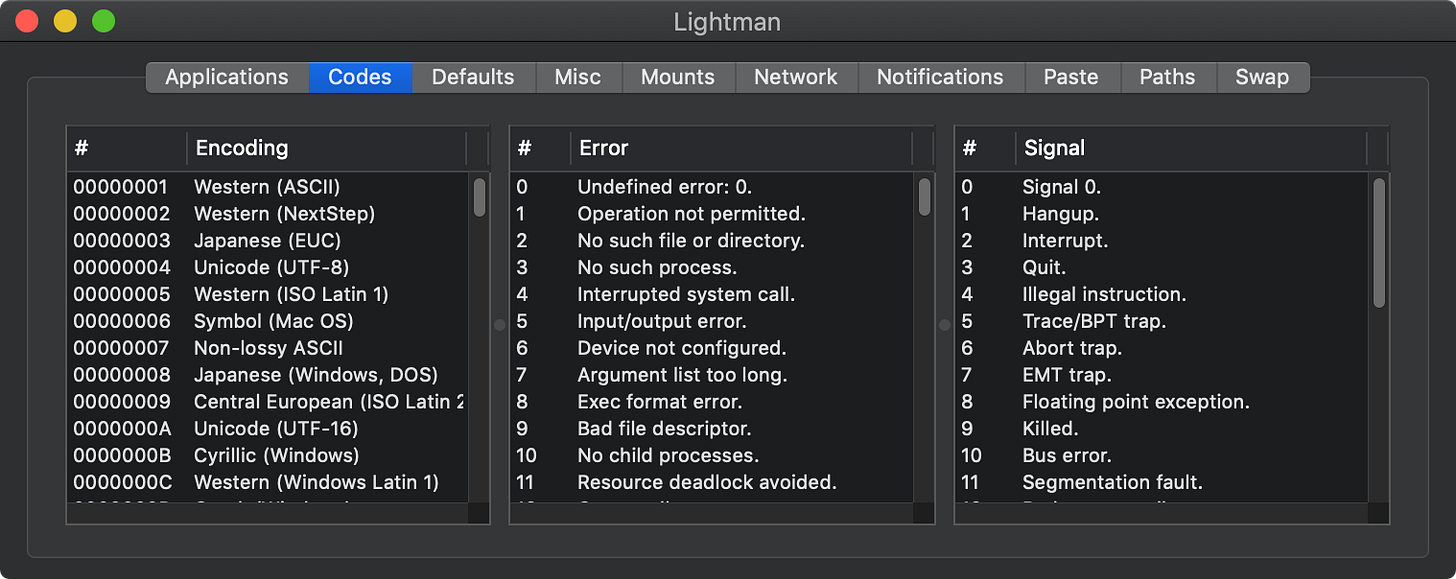Code in Search of a Home II
Part two, D-L.
Still looking for a home here. Slim pickings. We pick up with the Ds from last time’s A-C. As there are no Ds or Es, we move right up into the Fs.
Prologue
NeXT's NeXTSTEP had everything - but Apple.
NeXTSTEP was an attempt to bring workstation power to the PC. Its software and hardware technologies were unparalleled.
The structure of the NeXTSTEP code classes, the use of the world's - and to this day - only viable programming language fit for purpose: this put NeXT's NeXTSTEP OS in a class of its own.
Unfortunately, the fetish of Steve Jobs to bind the software to the hardware crippled the company. The intensity of this fetish was exemplified by his insistence to paint - and repaint and again repaint - the walls of his NeXT factory until they had just the right shade of beige.
Once the hardware project was finally scuppered, industry interest in the software - NeXTSTEP and later OPENSTEP - took off.
At the time of the 'merger', NeXT was finally projecting profits, with Apple on the other hand only weeks away from bankruptcy.
Rather than incorporating NeXT software 'as is' and going right back to market, the 'Maccies' in Apple insisted on a complete makeover to make the system more 'Mac-like' (whatever that is).
This resulted in the mishmash known as OS X.
There is no 'Mac' in Apple's OS X. There's only Unix and beige cobwebs.
As can be seen in the previous instalment, this instalment, and especially the coming instalments, too much time/effort had to be wasted to complement - and counteract - ‘beige box’ changes.
Apple finally escaped their corporate demise not by properly caring for their $429 million NeXT legacy but by their acquisition of external technologies not related to their cornerstone OS.
The transformation of the mobile market made Apple the most detestable and openly condemned IT corporation in modern times.
All the while IBM acquired Red Hat Linux for a staggering $34 billion.
History won't be kind to Tim Cook. Neither computer history nor history in general. No company, public or otherwise, has so desecrated something so universally lauded and appreciated as Tim Cook's Apple did with Unix and NeXTSTEP. No other Unix platform makes such a mess of things. No other Unix platform attempts to constrict developers and users like Apple. Paul Graham hasn't condemned other Unix platforms - only Apple.
FileInfo
FileInfo is a counterpart to CatInfo. Purely beige box. So 'no'.
But note, just for lulz, the 'location.h' and 'location.v' fields. One could have a field day going through all the tales here.
Of course the fields refer to the horizontal and vertical placement of an icon in a Finder window. Why is this important?
One use Apple found for them was to try to make sure nobody saw how they were screwing up their 'Unix' file system. They used impossibly high values.
fileCreator and fileType are impossibly inadequately dimensioned fields that had a chance for relevance only in the beige box days when ideally there was but one program and one folder to put it in.
\r
An older relative to '.HFS+ Private Directory Data\r' hid all the hard link files, as Apple, with their limited wits, couldn't find a way to accommodate this essential Unix feature. Note the '\r' at the end of the name. This is the actual carriage return character, which is not in use on Unix systems. There's no way ordinary Unix utilities can generate it. It takes a lot of work. You can't get it from an ordinary entry field in Apple's 'Unix'. This is how badly they wanted to prevent you from seeing what they were up to.
Otherwise you'd go to a command prompt and just sudo into the directory. But the '\r' won't work with a command prompt. Works nicely, doesn't it?
(One can create a shell that accepts ‘\r’ but the easiest way was to escalate Xfile and then use its ‘Goto’ facility. Nobody else on the platform would even consider it.)
Another facet of this spectacular story concerns one John Siracusa, a web designer who'd often volunteer to write egregious and effusive reviews of each point update Apple churned out - for another $129 per customer worldwide. John - who really looks like he's been embalmed, really - would regularly go off on a tangent and sing hymns to what he called 'spatiality', the idea that each 'folder window' on screen should always appear in the same place with all its icons in the exact same position as the time before. Something that early on crosses the border to 'ridiculous' when you realise that a modern Unix system can have upwards of 100,000 (one hundred thousand) directories. And that's not even considering the gunk left behind by Apple's Finder for each folder visited, or the fact that there's a bad bug in the app which Apple admit to without making a motion to fix.
But perhaps worst of all - the hallmark of John Siracusa - was when he admitted that he'd noticed how Apple had trashed the beautiful NeXT class system, how ugly things had become under the bonnet, all in pursuit of some unarticulated goal, and yet, in the end, he encourages the Apple screwups to keep on, continue to trash and wreck things, ending with the words - and this was not meant to be comical - 'keep up the good fight'.
Woke came to Apple ten years before the rest of the world. So bad it was.
Forker
A simple utility to either pare off or combine file forks. So 'no'. Note that Joe Blogs would have no control over what was happening on his system - in fact, this is actually how one of the classic hack attacks 'Oompa Loompa' worked.
We were in contact with the author of 'Oompa Loompa'. In fact it was he who contacted us. He said we were the only sane people in the 'World of Mac'. He absolutely hated Apple fanboys, as did we. And he wrote 'Oompa Loompa' just to teach them a lesson.
Look up 'Oompa Loompa' at our site and see. He had them crying in their pantyhose.
Fortune
Which just went through a bit of a makeover. Yes, this can and should be ported to any Unix platform if something equivalent in the GUI does not exist. This is from /usr/games and it contains some of the most legendary witticisms from Bell Labs.
GD
Or Gunga Din for long. This cute app monitors network connections. Shows you what protocols are in use, if there are any incoming or outgoing data queues and how big in such case, shows you the local and remote addresses and the ports they use, as well as the connection status.
The main GD window displays current connections. An auxiliary window keeps a list of all connections, present and past. Yes, this should be ported, and odds are good it's already available.
GDE
Get Directory Entries. A hefty topic. There are two APIs used to get the contents of a directory. The uppermost, used by file management, is readdir().
readdir() in turn calls getdirentries(). getdirentries() has a sane purpose in ordinary Unix: to prune away things file management would never want. Such as items scheduled for deletion.
But Apple bastardised this, using it to hide things they didn't want you to find.
The purpose of GDE was to expose this hypocrisy.
Which was all fine and good until Apple made the leap to 64-bit. At 64-bit they moved getdirentries() into the kernel where ordinary applications can no longer link to it.
This won't be needed on any other 'sane' Unix, so the answer is 'no'.
Hawkeye
Yes - why not? The Windows incarnation was used by a Wall Street commodities broker to prove an interruption with a margin call, saving the gent a lot of money. Pinging servers can be useful.
Keymaster Solo
The freeware version of Keymaster. As information preferably often be free, so should software to protect you from Apple’s dirty tricks.
What’s really amazing is that lot of people complain about Apple but no one does anything about it.
Well we did.
This is the simple version of what emanated from a lot of research. You’re able to seal your standard home directories.
Keymaster
They’ll never listen, they’ll never learn, they’ll only complain, and then ask for forgiveness. We don’t care.
This is the full version of Keymaster. Thumb your nose at all things Apple - they’re evil.
Lightman
‘I don’t know - but it’s great!’ - D Lightman
A kitchen sink. Completely different on Windows. Only the theme remains.
Applications. A list of all running Cocoa applications. Note that this is not the same as a list of all running processes. The data is in columns for the name of the application, its process identifier, its process serial number (high and low 32-bit parts) and its fully qualified path. As a convenience, Lightman provides a means of 'force quitting' applications.
Codes. String encodings and system error and signal codes together with their string representations.
Defaults. Your complete system defaults.
Misc. Your uptime both as an absolute value and in nanoseconds, your full user name, home directory, OpenStep root directory, temporary directory, your login name, the log page swapping size, the swap page size in bytes, real memory available, the current window count, the screens available, device descriptions of your deepest screen and main screen, available string encodings, the runtime environment, the file system attributes at root, details on the multiprocessing library, the computer's host address, the host byte order, the host name, the operating system name, and the operating system version string.
Mounts. Information on all mounted file systems.
Network. The contents of the protocol, rpc program number, and services databases.
Paste. Available format and change count for the drag, find, font, general, and ruler pasteboards. (Yes, Victoria, unlike Windows, NeXT has lots of pasteboards/clipboards.)
Paths. Search paths defined by Cocoa and the underlying Unix system. There are many categories here, and the paths listed will give you a good idea of where you best can store your own applications, frameworks, and the like.
Swap. Snapshots of the MACH virtual memory system's active pages, copy on writes, free pages, inactive pages, the object cache hit rate, object cache hits, object cache lookups, page faults, pageins, pageouts, reactivated pages, wired down pages, and zeroed pages. Lightman lets you compare current snapshots with your three immediately previous snapshots.
Lightman also incorporates Seahaven, a 'Keymaster Lite'.
All platforms have their own ‘kitchen sinks’. So ‘yes’.
Luffarschack
This was Supertic on Windows, in two versions: 10x10 and 20x10.
An idea would be a limitless game board - shouldn't be impossible, although it could eat up lots of RAM. But if time's available...













